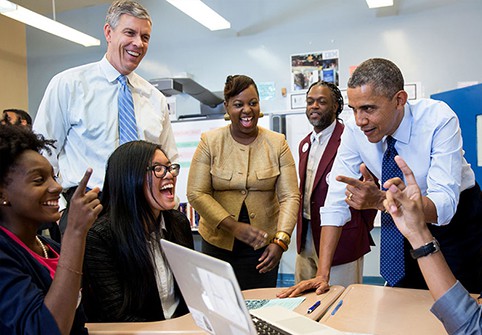Driving Innovation from the White House

Tom Kalil is a California guy but he has spent 14 years encouraging U.S. innovation from the White House. Kalil leads the Office of Science and Technology Policy (@whitehouseostp). He served president Clinton as well as president Obama.
OSTP promotes innovation and entrepreneurship, STEM education, basic and applied science, climate change, open data, and cyber security.
Over breakfast last week, Kalil said he was excited about the White House BRAIN initiative, a comprehensive research initiative seeking to understand the human mind to uncover new ways to treat, prevent and cure brain disorders. Launched as a $300 million public-private initiative, Kalil said it could guide the investment of more than $4 billion to be spent over 12 years.
The White House will host its own Demo Day (#WHDemoDay) on August 4. “Unlike a private-sector Demo Day, where entrepreneurs pitch their ideas to funders, innovators from around the country will join President Obama to “demo” their individual success stories and show why we need to give every American the opportunity to pursue their bold, game-changing ideas,” said Kalil, who called it chance to promote an inclusive innovation economy.
White House efforts to grow inclusive entrepreneurship include:
- Startup in a Day: Working with cities and states to simplify the process of getting a new venture off the ground, developing online tools that help entrepreneurs discover and apply — in less than a day — for local, state, and Federal permissions needed to start a business.
- TechHire: Engaging with local governments and the private sector to help Americans get the skills they need for a technology-driven workplace.
- I Corps: Helping university researchers and students learn to commercialize their breakthrough inventions.
- Startup America: A $1 billion impact investment initiative, connected clean energy startups with experienced mentors, supported legislation that is making it easier for startups to raise capital, and much, much more.
OSTP Chief of Staff Cristin Dorgelo and I worked together at the X Prize Foundation. She knows prizes and pull mechanisms as well as anyone. Kalil and Dorgelo have been instrumental in the big increase in the federal use of prizes to promote breakthroughs and creative approaches to market development.
Borrowing a market aggregation strategy for the global pneumonia fight, the Department of Energy promoted energy efficient buildings by developing a non-binding expression of interest which elicited a strong market response. “We need greater use of these approaches to solve domestic problems as well,” said Kalil.
Kalil sees more financial innovation internationally. Under Raj Shah’s leadership, USAID served as an important market shaper.
Big advances in society are often a product of partnerships that take advantage of the unique benefits of public, philanthropic, and private capital (as discussed in chapter 5 of Smart Cities) it’s important to use the right form of capital for the right job. Compared to the politically mired domestic conversation, Kalil sees a rich international conversation about innovative capital stacks that leverage private debt and venture capital.
Leveraging the venture strategy of milestone payments, the feds have been engaging private enterprise in useful ways. Kalil notes the use of commercial cargo flights to the space station and the development of open education resources as examples.
For more see:








0 Comments
Leave a Comment
Your email address will not be published. All fields are required.